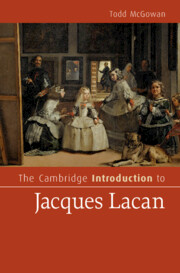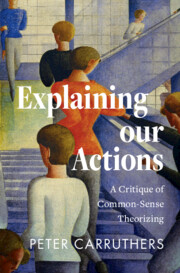Refine search
Actions for selected content:
146 results
16 - The Artistic Identity
- from Part IV - Realities
-
- Book:
- The Artist's Life
- Published online:
- 04 November 2025
- Print publication:
- 20 November 2025, pp 113-122
-
- Chapter
- Export citation
Chapter 14 - Whym Chow: Flame of Love and Animal Poetry
- from Part II - Forms and Genres
-
-
- Book:
- Michael Field in Context
- Published online:
- 03 October 2025
- Print publication:
- 25 September 2025, pp 123-132
-
- Chapter
- Export citation
Structural Rationality in Desire
-
- Article
-
- You have access
- Open access
- HTML
- Export citation
Desire, dissatisfaction, dispersal: The oddness of desiring God
-
- Journal:
- Scottish Journal of Theology , First View
- Published online by Cambridge University Press:
- 18 August 2025, pp. 1-12
-
- Article
-
- You have access
- Open access
- HTML
- Export citation
Chapter 10 - Temperance
- from Part IV - Virtues of Indirect Caring
-
- Book:
- Attention to Virtues
- Published online:
- 25 July 2025
- Print publication:
- 14 August 2025, pp 238-258
-
- Chapter
- Export citation
Marketing, Narratives, and Consumer Desire within Auction Catalogs of Cultural Objects
-
- Journal:
- Advances in Archaeological Practice / Volume 13 / Issue 1 / February 2025
- Published online by Cambridge University Press:
- 13 August 2025, pp. 17-30
-
- Article
-
- You have access
- Open access
- HTML
- Export citation
Preface
-
- Book:
- The Cambridge Introduction to Jacques Lacan
- Published online:
- 17 July 2025
- Print publication:
- 31 July 2025, pp ix-xiv
-
- Chapter
- Export citation
Chapter 2 - Plato’s Problems with Aversion
- from Part II - Motivational Challenges to Self-Rule
-
-
- Book:
- Platonic Autonomy
- Published online:
- 07 August 2025
- Print publication:
- 31 July 2025, pp 45-57
-
- Chapter
- Export citation

The Cambridge Introduction to Jacques Lacan
-
- Published online:
- 17 July 2025
- Print publication:
- 31 July 2025
Chapter 4 - Beyond
-
- Book:
- Embodiment in Nineteenth-Century American Literature
- Published online:
- 29 June 2025
- Print publication:
- 17 July 2025, pp 126-149
-
- Chapter
- Export citation
Chapter 7 - The Philosophy of Desire
-
- Book:
- Ovid and Plato
- Published online:
- 19 June 2025
- Print publication:
- 03 July 2025, pp 114-140
-
- Chapter
- Export citation
Chapter 5 - Decision-Making and Goals
-
- Book:
- Explaining our Actions
- Published online:
- 17 April 2025
- Print publication:
- 08 May 2025, pp 91-113
-
- Chapter
- Export citation
Chapter 6 - Pleasure and (Affective Forms of) Desire
-
- Book:
- Explaining our Actions
- Published online:
- 17 April 2025
- Print publication:
- 08 May 2025, pp 114-134
-
- Chapter
- Export citation
Anti-Theists cannot have Theistic Faith
-
- Journal:
- Canadian Journal of Philosophy / Volume 54 / Issue 3 / April 2024
- Published online by Cambridge University Press:
- 24 April 2025, pp. 219-229
-
- Article
-
- You have access
- Open access
- HTML
- Export citation

Explaining our Actions
- A Critique of Common-Sense Theorizing
-
- Published online:
- 17 April 2025
- Print publication:
- 08 May 2025
5 - Finding an Ending
-
- Book:
- The Theological Imagination
- Published online:
- 09 November 2024
- Print publication:
- 07 November 2024, pp 127-160
-
- Chapter
- Export citation
4 - Looking for God
-
- Book:
- The Theological Imagination
- Published online:
- 09 November 2024
- Print publication:
- 07 November 2024, pp 105-126
-
- Chapter
- Export citation
4 - Framing, polyphony and desire: Theocritus and Hellenistic poetics
-
- Book:
- The Poet's Voice
- Published online:
- 31 October 2024
- Print publication:
- 13 June 2024, pp 223-283
-
- Chapter
- Export citation
24 - Queering Desire in American Science Fiction
- from Queer Genre
-
-
- Book:
- The Cambridge History of Queer American Literature
- Published online:
- 17 May 2024
- Print publication:
- 06 June 2024, pp 426-439
-
- Chapter
- Export citation
25 - Queering Comics Histories
- from Queer Genre
-
-
- Book:
- The Cambridge History of Queer American Literature
- Published online:
- 17 May 2024
- Print publication:
- 06 June 2024, pp 440-454
-
- Chapter
- Export citation
